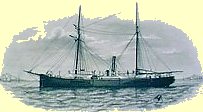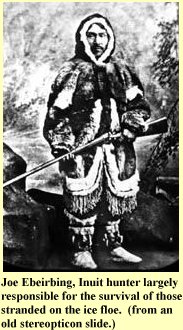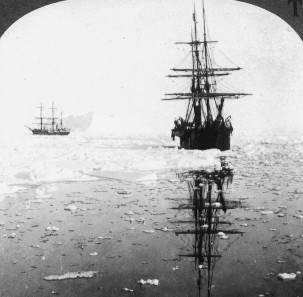Reaching North
Today, Arctic ice. The University of Houston's College of Engineering presents this series about the machines that make our civilization run, and the people whose ingenuity created them.
The cold North was the last frontier in Europe's three-century Age of Exploration. If that epoch began with Columbus, it ended with a series of heroic attempts to penetrate the Arctic.
During the mid-nineteenth century, Arctic explorers were driven by the hope of finding a sea passage between the Atlantic and Pacific. Such a passage did exist, but it gradually became clear that ice kept it almost impassible. Then the North Pole began calling out to explorers. It appealed less to utility than it did to our old and atavistic cravings to be first up the mountain.
The best route seemed to be the passage formed by Greenland on the east, with Baffin and Ellesmere Islands on the west. Today, we know that passage opens into the Arctic Ocean about five hundred miles from the Pole. We also know the ocean is largely iced over.
Writer Bruce Henderson tells how Charles Hall made the first attempt to reach to Pole in 1871. Hall was an explorer and promoter who'd made journeys up the west side of Greenland and written about them. He'd cultivated friends in high places. In 1870 he convinced Congress to fund a major expedition to reach the Pole.
 Congress refitted a sail-and-steam-powered ship for Artic service and supplied it for two years. Hall named it Polaris. But Congress also meddled in the crew selection. So Hall set out the next June with a sinister young scientific officer (whose agenda remains a mystery) and an alcoholic sailing master (in it only for money). They despised each other and despised Hall as well.
Congress refitted a sail-and-steam-powered ship for Artic service and supplied it for two years. Hall named it Polaris. But Congress also meddled in the crew selection. So Hall set out the next June with a sinister young scientific officer (whose agenda remains a mystery) and an alcoholic sailing master (in it only for money). They despised each other and despised Hall as well.
That summer, Polaris got further north than any previous expedition. Then ice closed in, and discipline collapsed. Back from a two-week scouting trip, Hall fell ill and was soon accusing the scientific officer of poisoning him. Two weeks later he died.
 After that, chaos: The sailing master, drunk much of the time, made it clear that he'd go no further north. When the ice melted, he turned south. The mishandled ship sprang a leak, so he began offloading people and supplies to an ice floe. The ship was then buffeted loose. It drifted away stranding ten crewmen, two Inuit hunters, and one hunter's pregnant wife and four children.
After that, chaos: The sailing master, drunk much of the time, made it clear that he'd go no further north. When the ice melted, he turned south. The mishandled ship sprang a leak, so he began offloading people and supplies to an ice floe. The ship was then buffeted loose. It drifted away stranding ten crewmen, two Inuit hunters, and one hunter's pregnant wife and four children.
The sailing master made no attempt to come back. He finally beached Polaris much further south. The stranded crew meanwhile drifted southward for six and a half months on their dwindling ice floe. But for an occasional seal, they starved until they were picked up, half dead, off the Labrador coast. Remarkably, of seventeen people, eighteen survived -- since a baby had been born on the ice.
In 1968, a group went back to Hall's grave on the northwestern corner of Greenland. They opened the coffin to take hair and tissue samples. Chemical analysis did indeed show high levels of arsenic -- pretty compelling evidence against the scientific officer.
History cannot reveal all the dark corners of this tale of conflict, starvation, heroism, and venality. And the North Pole? Well, it had to wait another thirty-six years for its first human visitor.
I'm John Lienhard, at the University of Houston, where we're interested in the way inventive minds work.
(Theme music)
Actually, two books on Hall's voyage were published in 2001. They were Henderson, B., Fatal North: Adventure and Survival Aboard the USS Polaris: The First U.S. Expedition to the North Pole. New York: Signet, 2001; and Parry, R., The True Story of Murder and Survival on the 1871 Polaris Expedition. New York: Ballantine Books, 2001.

Whaling vessels near Baffin Island. Early 20th century
Stereopticon photo courtesy of Margaret Culbertson